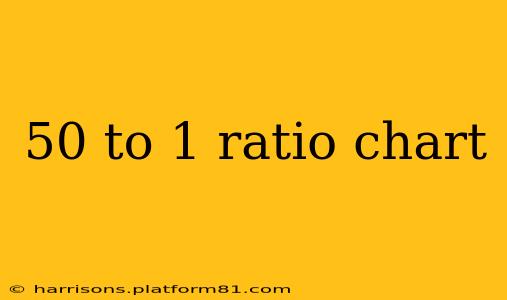Understanding and Utilizing 50:1 Ratio Charts
A 50:1 ratio chart, also sometimes referred to as a 50-to-1 ratio chart, isn't a standard, formally defined chart type like a bar chart or pie chart. The term usually refers to a visual representation showcasing a significant disparity between two values – one being 50 times larger than the other. This type of visual is powerful for highlighting extreme differences and is frequently used in various fields, including:
- Finance: Comparing large market capitalizations to smaller investments.
- Science: Representing contrasting scales in experiments or measurements (e.g., comparing the size of a planet to a specific feature on its surface).
- Engineering: Illustrating the difference in size or capacity between two components in a system.
This article will explore how to interpret and create visualizations that effectively communicate a 50:1 ratio, discussing various chart types that can be adapted to best represent this significant difference. We'll also address common questions surrounding this type of data representation.
What is the best way to visualize a 50:1 ratio?
The best way to visualize a 50:1 ratio depends on the specific context and the data you're trying to represent. Simple bar charts or logarithmic scales can be quite effective. Let's look at each:
-
Bar Chart: A simple bar chart can effectively illustrate the difference, but with a 50:1 ratio, the smaller bar will be almost invisible unless you use a significantly scaled-down version of the larger bar. This can lead to misinterpretations.
-
Logarithmic Scale: A logarithmic scale (log scale) is a far superior choice for visualizing large differences in magnitude. Log scales compress large ranges of data, allowing both the smaller and larger values to be displayed proportionally without one overwhelming the other.
How do I create a 50:1 ratio chart in Excel?
Excel offers various tools to create charts illustrating a 50:1 ratio. Here's a step-by-step guide:
-
Input Data: Enter your two values into an Excel spreadsheet. For example, let's say one value is 5000 and the other is 100.
-
Choose Chart Type: Select the data and go to the "Insert" tab. Choose a column chart (bar chart) or a scatter plot.
-
Apply Logarithmic Scale (Recommended): For a 50:1 ratio, you'll get a much clearer and more informative representation by changing the chart's axis scale to logarithmic. To do this (for a column chart, for example):
- Right-click on the vertical axis (y-axis).
- Select "Format Axis".
- In the "Axis Options" pane, check the "Logarithmic scale" box.
- Adjust the minimum and maximum bounds as needed for optimal visualization.
-
Label and Title: Add clear labels to your axes and a concise title that accurately reflects the data.
Are there other ways to present a 50:1 ratio visually?
Yes, there are alternatives besides bar charts, particularly useful for specific presentations:
-
Proportional Circles: Circles with areas proportional to the values can visually communicate the ratio, although accurately interpreting the areas might require some effort.
-
Stacked Bar Chart: While not ideal for such a large disparity, a stacked bar chart could showcase the relative proportions if appropriately scaled. The smaller segment will be incredibly small, however.
-
Infographic: For complex or multi-faceted data comparisons, an infographic might provide a better visual representation, especially if other related information needs to be included.
How can I interpret a 50:1 ratio chart?
Interpreting a well-constructed 50:1 ratio chart simply means understanding that one value is 50 times greater than the other. For example, if a chart represents sales figures, and one product has sales 50 times higher than another, the chart should visually convey that significant difference clearly. The key is to look for accurate scaling, appropriate labels, and a clear title to understand the presented information.
By choosing the right charting technique and carefully considering the scaling, you can effectively and accurately communicate the substantial difference represented by a 50:1 ratio. Remember that the goal is clear and unambiguous communication.
